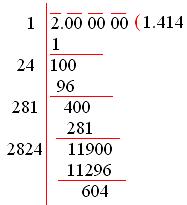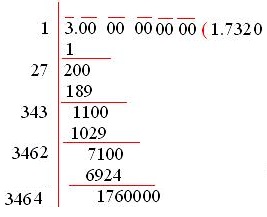Subscribe to our ▶️ YouTube channel 🔴 for the latest videos, updates, and tips.
Square Root of Numbers that are Not Perfect Squares
Square root of numbers that are not perfect squares or to find the value of square root correct up to certain places of decimal are:
If we have to find the square root of a number up to ‘n’ places of decimals, the number of digits in the decimal part must be 2n. If they are less than 2n, then affix suitable number of zeros to the extreme right of the decimal part.
Find the square root of decimal number using long division method.
But if we have to find the square root of number correct up to ‘n’ places of decimal, then find the square root of number up to (n + 1) places of decimal.
If the digit at the (n + 1) decimal place is equal to 5 or greater than 5, then the digit at ‘n’ place increases by 1.
If the digit at (n + 1) decimal place is less than 5, then the digit at ‘n’ place remains the same and deletes the digit at (n + 1) place.
This is how we find the square root correct up to n decimal places.
Examples on square root of numbers that are not perfect squares are given below:
1. Evaluate √2 correct up to two places of decimal.
Solution:
Using the division method, we may find the value of √2;

Therefore, √2 = 1.414 ⇒ √2 = 1.41 (correct tip to 2 places of decimal)
2. Evaluate √3 correct up to 3 places of decimal.
Solution:
Using the division method, we may find the value of √3;

Therefore, √3 = 1.7324 ⇒ √3 = 1.732 (correct tip to 3 places of decimal)
3. Evaluate √0.8 correct up to two places of decimal.
Solution:
Using the division method, we may find the value of √0.8 as shown below.

Therefore, √0.08 = 0.894 ⇒ √0.8 = 0.89 (correct tip to 2 places of decimal)
● Square Root
Square Root of a Perfect Square by using the Prime Factorization Method
Square Root of a Perfect Square by Using the Long Division Method
Square Root of Numbers in the Decimal Form
Square Root of Number in the Fraction Form
Square Root of Numbers that are Not Perfect Squares
Practice Test on Square and Square Roots
● Square Root- Worksheets
Worksheet on Square Root using Prime Factorization Method
Worksheet on Square Root using Long Division Method
Worksheet on Square Root of Numbers in Decimal and Fraction Form
8th Grade Math Practice
From Square Root of Numbers that are Not Perfect Squares to HOME PAGE
Didn't find what you were looking for? Or want to know more information about Math Only Math. Use this Google Search to find what you need.


New! Comments
Have your say about what you just read! Leave me a comment in the box below. Ask a Question or Answer a Question.